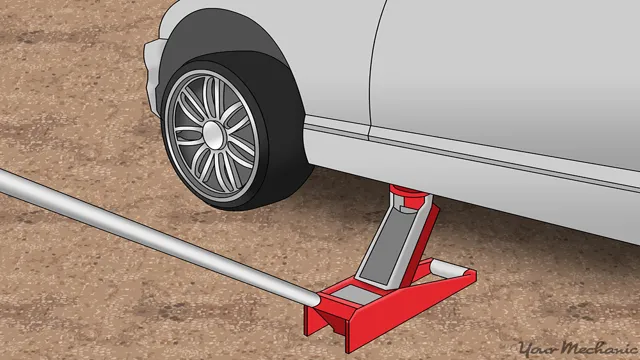Have you ever changed a tire or worked on your car underneath it? If so, you know how important it is to use jack stands properly. Jack stands are essential tools for ensuring your safety while working on your vehicle. However, improper use of jack stands can lead to serious accidents.
In this blog post, we’ll cover everything you need to know about using jack stands safely and effectively. We’ll go over the different types of jack stands, how to choose the right ones for your car, and the proper steps to use them. So, buckle up and let’s get started!
Introduction
Jack stands are an essential tool for anyone who wants to perform repairs or maintenance on their vehicle. These simple but effective structures stabilize your car by elevating it off the ground, allowing you to safely work underneath it. However, it’s important to remember that using jack stands improperly can be dangerous or even deadly.
To ensure that you’re using them correctly, start by selecting the right type of jack stand for your car and following the manufacturer’s instructions for setting it up. This typically involves positioning the stand on a flat, stable surface, adjusting the height to the appropriate level, and locking it in place. Always double-check that the jack stand is securely in place before working under the car.
Finally, remember to never exceed the rated weight capacity of your jack stand and to keep your hands and feet clear of any moving parts. By following these simple steps, you can use jack stands safely and confidently for all your automotive needs.
What are jack stands?
Jack stands are an essential tool for anyone who works with cars or does their own repairs. If you’re not familiar with them, jack stands are devices that are used to hold a car in place while it’s being worked on. They come in pairs and are made of heavy-duty steel, with a flat base and a tall, adjustable neck.
Jack stands are designed to support the weight of a car and keep it stable, so that you can work underneath it safely. They are an important safety feature, and should always be used when working under a car. In short, jack stands are a must-have for any DIY mechanic or car enthusiast.

Why are jack stands important?
Jack stands are an essential tool for anyone who works on their vehicle. These steel props are placed under your car to hold it in place while you work underneath. They provide superior stability and safety compared to just using a car jack.
Even though car jacks can lift a vehicle, they are not reliable enough to keep it up for an extended period of time. Jack stands, on the other hand, are designed to support the weight of your car without fail. They come in different shapes and sizes to accommodate various types of vehicles.
Without jack stands, working under your car is a risky and potentially fatal task. Therefore, investing in a high-quality set of jack stands is crucial for the longevity of your vehicle and your safety.
Choosing the Right Jack Stand
When it comes to working on your car, safety is essential. Jack stands are the perfect tool to ensure that your car remains steady and secure while you work underneath it. However, with so many jack stands available in the market, choosing the right one can be confusing.
To determine which jack stand is right for you, you need to consider a few factors. First, consider the weight capacity of the jack stand. It’s crucial to make sure that the stand can safely support the weight of your vehicle.
Next, check the height range of the stand and ensure that it can reach the desired height. Also, look for a jack stand that is easy to use and has a secure locking mechanism. Finally, always remember to use jack stands on a flat, stable surface and follow the manufacturer’s instructions for safe use.
By following these steps, you can be assured that you’re using the right jack stand and that you’re taking all necessary safety precautions while working on your car. Remember, your safety should always come first!
Weight capacity
When it comes to choosing the right jack stand, weight capacity is an essential factor to consider. You don’t want to risk damaging your vehicle or, even worse, injuring yourself by selecting a jack stand that can’t handle the weight of your car. It is important to check the weight rating of the jack stand before purchasing or using it.
A good rule of thumb is to select a jack stand that can accommodate at least 75% of your vehicle’s weight. For instance, if your car weighs 4,000 pounds, you’ll want a jack stand with a weight capacity of 3,000 pounds or more. Keeping the weight capacity in mind will ensure that your jack stand is durable and safe, providing you with peace of mind during any automotive repair or maintenance work.
Don’t take chances with your safety: pick the right jack stand with an appropriate weight capacity before using it on your vehicle.
Adjustability
When choosing the right jack stand, one of the essential considerations is adjustability. You want to ensure that the jack stand you purchase can be adjusted to the appropriate height to suit your vehicle’s specific needs. Adjustable jack stands come in a variety of weight capacities, so you should consider the weight of your vehicle when making your purchase.
An adjustable jack stand with a larger weight capacity is ideal for larger vehicles, while one with a lower weight capacity may be suitable for smaller vehicles. Additionally, look for jack stands that offer multiple height adjustment options, allowing you to easily raise and lower the stand to the appropriate height. By choosing an adjustable jack stand, you can ensure safe and stable support when working on your vehicle.
Construction material
When it comes to selecting the right construction material, one must carefully consider a number of factors. However, choosing the right jack stand is especially crucial for construction workers who prioritize safety. The material of the jack stand is as important as its load capacity and height range.
While many construction workers may opt for steel jack stands due to their durability, aluminum jack stands have their own benefits. Aluminum stands are significantly lighter, making them easier to transport from one job site to the next. They also don’t rust, making them ideal for outdoor projects where moisture is a concern.
Ultimately, the material of a jack stand is a key factor in determining its suitability for any given project, but construction workers must take into account all aspects of the stand, including its weight, height range, and load capacity, before making their final choice.
Preparing Your Vehicle for Jack Stand Use
Whether you’re doing some routine car maintenance or making repairs, jack stands can come in handy. However, it is important to note that misusing jack stands can lead to serious accidents and injures. Before using jack stands, make sure you inspect your vehicle’s undercarriage for any signs of damage or corrosion.
Make sure you select a level surface to park your car and use the parking brake. Turn off your engine and set up the jack according to the manufacturer’s instructions. Lift the car on the point recommended by the manufacturer, then place the jack stand under a sturdy part of the car’s frame.
Lower the car onto the stands, and give it a firm shake to ensure that it is secure. Repeat the process for the second jack stand. It is essential always to place them in pairs since a single jack stand cannot hold the weight of your vehicle.
When you’re done, before you lower your vehicle, double-check to ensure the stands are stable and secure. By following these steps, you can ensure that you’re safely using jack stands.
Selecting a suitable surface
When preparing your vehicle for jack stand use, one crucial factor to consider is selecting a suitable surface. The surface you choose should be firm and level, with no chance of sinking or shifting as you work on your vehicle. Ideally, a concrete garage floor or well-paved driveway is the best option.
Avoid using grass, dirt, or gravel surfaces, as they can be unstable and lead to accidents. Before setting up your jack stand, also make sure to clear any debris, oil spills, or standing water on the surface. By taking the time to choose the right surface, you can ensure that your jack stand will remain stable and secure throughout your work, keeping you safe in the process.
Locating the jack points
Locating the jack points on your vehicle is an essential step in preparing for jack stand use. First, consult your owner’s manual for instructions on where to place the jack stands. Once you’ve located the jack points, ensure that they are clean and free of debris.
Position the jack under the jack point and pump it up until it makes contact with the car’s frame. It’s important to note that not all vehicles have the same jack points or weight distribution. It’s crucial to select a location that can support the weight of your vehicle so that it doesn’t tip or fall off the jack stand.
Always double-check that the jack stand is securely in place before getting underneath the vehicle. Remember, safety should always be your top priority when working on your vehicle.
Lifting your vehicle with a jack
Lifting your vehicle with a jack can be a daunting task, but with the right preparation, it can be done safely and effectively. Before using jack stands, it’s important to ensure your vehicle is on a level surface and the parking brake is engaged. You should also place chocks or bricks behind the wheels to prevent any rolling.
Once you’ve secured the vehicle, locate the recommended jack points in your car’s owner’s manual. These are typically located along the frame or designated jacking points. Avoid jacking up the vehicle on any other parts that could potentially be damaged.
When placing the jack, ensure it’s squarely centered under the jacking point and that it has a solid grip. Carefully lift the vehicle until it’s high enough to fit the jack stand below. Lower the vehicle onto the jack stand and make sure it’s secure before removing the jack.
Taking the time to prepare your vehicle before using jack stands will help ensure a safe and successful lift.
Placing the Jack Stands
Using jack stands is a crucial step in ensuring one’s safety when working on a vehicle. When placing jack stands, it’s essential to find the designated lifting points on the vehicle and position the stand securely underneath them. To do this, slowly lower the vehicle onto the jack stand until it’s met with resistance.
Check the placement of the stand to ensure that it’s correctly positioned and level before starting work. Before making any adjustments or removing the jack stands, ensure that the stands are stable and that the vehicle is secure before proceeding. Remember, proper use of jack stands can prevent accidents and keep you and your vehicle out of harm’s way.
So, always double-check before starting any work, and never take shortcuts when it comes to safety!
Positioning the stands
When it comes to working under a vehicle, safety should always be the top priority. Placing the jack stands is an essential step in ensuring that the car is supported properly and won’t fall while you’re underneath it. Firstly, make sure to park the car on a level surface and engage the parking brake.
Then, locate the designated jack points under the car and use the floor jack to lift the vehicle. Once the car is up, slide the jack stands under the jack points and slowly lower the car onto the stands. Remember to double-check that the stands are secure and evenly positioned before getting under the car.
By taking the time to properly position the stands, you’re making sure that your workplace is safe and secure, allowing you to focus on the task at hand.
Securing the stands
When it comes to DIY car maintenance, securing the stands is an essential step to keep yourself safe. Placing the jack stands correctly is crucial to prevent the car from toppling over and causing harm. Firstly, make sure the ground is level and stable before proceeding.
Then, choose a sturdy jack and lift the car slowly and carefully. Once the car is high enough, position the jack stands under the designated points of the vehicle. It’s better to put the stands one at a time, alternating between them, to distribute the weight evenly.
Once the stands are in place, carefully lower the car onto them and make sure they’re secure. Give the car a gentle push to check that it doesn’t wobble or move. Don’t forget to double-check the stands before starting work.
Secure stands mean you can be confident working on the car without worrying about your safety.
Lowering Your Vehicle
Lowering your vehicle can be a great way to improve its performance and appearance, but it’s important to do it properly to avoid any accidents or damage. One essential step in this process is using jack stands. These are devices that you can place under your car to support it while you work on it.
To use jack stands, first, you need to find a flat and stable surface to place them on. Then, use a hydraulic jack to lift your car to the point where you can safely place the jack stand underneath it. Once you have positioned the stand, lower your car onto it and make sure that it is firmly in place.
It’s important always to use at least two jack stands when working underneath your car – never rely on just one. Furthermore, remember to never get underneath your vehicle unless it is securely supported by jack stands. By taking these precautions, you’ll be able to safely lower your vehicle without any worries.
Removing the jack
Removing the jack is an important step to safely lower your vehicle after making repairs or tire changes. First, ensure your car is on a level surface and apply the parking brake. Then, use your lug wrench to loosen the lug nuts on the wheel you wish to change or repair.
Next, use the jack to raise the vehicle until the tire clears the ground. After completing the necessary repairs, remove the wheel and replace it with the spare if needed. Then, carefully lower the vehicle by turning the jack handle counterclockwise.
Once safely on the ground, tighten the lug nuts in a star pattern and check the tire pressure. Removing the jack and storing it back in its proper place is the final step in getting your car back on the road. Remember to always follow the manufacturer’s instructions and practice safe lifting techniques to avoid injury or damage to your vehicle.
Testing the stability of the jack stands
One of the most important things to consider when lowering your vehicle is the stability of your jack stands. It can be tempting to rush through this step, but taking the time to ensure that your stands are secure can prevent serious accidents and injuries down the road. The first thing to check is the weight capacity of your stands – they should be able to support the full weight of your vehicle without any strain.
Once you’ve confirmed this, it’s important to test the stability of your stands before you begin working. This can be done by shaking your car gently while it’s up on the stands – if they wobble or feel unsteady at all, you should readjust and test them again until they feel completely secure. Remember, your safety and the safety of those around you should always be your top priority when working on your car.
Conclusion
So there you have it, folks! Properly using jack stands is no rocket science, but it does require a little bit of common sense and care. Treat your car right and it’ll treat you right in return. With jack stands, you’ll be able to do all sorts of maintenance work and repairs on your vehicle safely and confidently.
Just remember to follow these simple steps and you’ll be cruising down the road smoothly in no time! As the old saying goes, “Safety first, fun second!” Happy wrenching!”
FAQs
What are jack stands and why are they important for vehicle maintenance?
Jack stands are support devices used to hold up vehicles while performing maintenance or repairs. They are important for ensuring the safety of both the person working on the vehicle and the vehicle itself.
How do I properly choose the right jack stand for my vehicle?
You should choose a jack stand with a weight capacity that exceeds the weight of your vehicle. Additionally, the height of the jack stand should be adjustable to fit the lifting points of your particular vehicle.
Can I use jack stands on uneven ground?
It is not recommended to use jack stands on uneven ground as this can cause the vehicle to become unbalanced and potentially fall off the stands. It is important to ensure that the ground is level and stable before using jack stands.
Can I use a jack stand as a replacement for a car lift?
Jack stands are not a replacement for a car lift and should only be used for short-term maintenance or repairs. Car lifts provide a more stable and secure way to work on a vehicle for extended periods of time.
How many jack stands do I need to properly support my vehicle?
You should always use at least two jack stands to support your vehicle, one for each side. This helps to distribute the weight evenly and prevent the vehicle from becoming unbalanced.
What should I do if my vehicle begins to shift while on jack stands?
If your vehicle begins to shift or become unbalanced while on jack stands, slowly lower it back down to the ground and reposition the stands to ensure proper support.
Is it safe to work underneath a vehicle while on jack stands?
It is not recommended to work underneath a vehicle while it is on jack stands as this can be very dangerous. Always use additional support devices, such as ramps, to elevate the vehicle to a safe working height.






